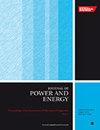Numerical investigation on vortex cooling flow and heat transfer characteristics for gas turbine blade with variable coolant chamber cross-sectional shapes
IF 1.1
4区 工程技术
Q3 ENGINEERING, MECHANICAL
Proceedings of the Institution of Mechanical Engineers, Part A: Journal of Power and Energy
Pub Date : 2023-08-23
DOI:10.1177/09576509231196210
引用次数: 0
Abstract
In this paper, according to the actual size of gas turbine blade interior space, eight vortex cooling models with different cross-sectional shapes of coolant chambers are established. Rectangular, Circle, Trapezoidal up, Trapezoidal down, Ellipse up, Ellipse down, Sine up and Sine down are the eight coolant chamber shapes. Functions of variable coolant chamber structures on vortex cooling flow and heat exchange characteristics are numerically analyzed by verifying the Standard k- ω turbulence model and conducting grid independence analysis. Research results show that the heat exchange ability of Sine up coolant chamber is the best compared with the other coolant chambers. The cool air enters the vortex chamber at a faster speed and impacts on the target surface to form a high-pressure area and a low-temperature swirl. The more the cool air moves downstream, the greater the turbulent kinetic energy becomes, which is more conducive to the heat transfer. Therefore, Sine up coolant chambers have the highest thermal performance factor. Due to the low drag coefficient and high target surface average Nusselt number of Ellipse up, its thermal exchange performance is second only to that of Sine up. Circle coolant chamber will not bring favorable factors to engineering application because of the slowest flow speed and the worst heat exchange capacity. For Trapezoidal up and Trapezoidal down, the flow velocity, pressure distribution, turbulent kinetic energy intensity and heat transfer uniformity are almost the same as Rectangle coolant chamber. The models of Ellipse down and Sine down coolant chambers exhibit less turbulent kinetic energy strength to heat transfer and higher temperature in the vortex chamber, and it is not suggested for cooling system optimal design.变冷却室截面形状燃气轮机叶片涡冷流动及换热特性数值研究
本文根据燃气轮机叶片内部空间的实际尺寸,建立了8种不同冷却腔截面形状的涡旋冷却模型。矩形、圆形、梯形向上、梯形向下、椭圆形向上、椭圆形向下、正弦向上和正弦向下是冷却室的八种形状。通过验证标准k- ω湍流模型并进行网格无关性分析,数值分析了不同冷却室结构对旋涡冷却流动和换热特性的影响。研究结果表明,与其他冷却室相比,正弦上升冷却室的换热能力最好。冷空气以更快的速度进入涡流室,撞击目标表面,形成高压区和低温涡流。冷空气越往下游移动,湍流动能越大,更有利于换热。因此,正弦向上冷却室具有最高的热性能系数。由于椭圆向上的阻力系数小,目标表面平均努塞尔数高,其换热性能仅次于正弦向上。圆形冷却室由于其流动速度最慢,换热能力最差,不会给工程应用带来有利因素。上、下梯形冷却室的流速、压力分布、湍流动能强度和换热均匀性与矩形冷却室基本相同。椭圆型和正弦型冷却室的湍流动能强度对换热的影响较小,涡流室温度较高,不适合冷却系统优化设计。
本文章由计算机程序翻译,如有差异,请以英文原文为准。
求助全文
约1分钟内获得全文
求助全文
来源期刊

CiteScore
3.30
自引率
5.90%
发文量
114
审稿时长
5.4 months
期刊介绍:
The Journal of Power and Energy, Part A of the Proceedings of the Institution of Mechanical Engineers, is dedicated to publishing peer-reviewed papers of high scientific quality on all aspects of the technology of energy conversion systems.
 求助内容:
求助内容: 应助结果提醒方式:
应助结果提醒方式:


